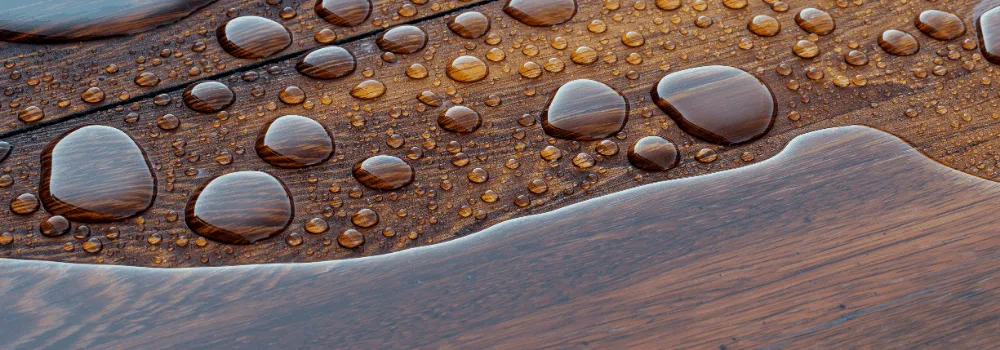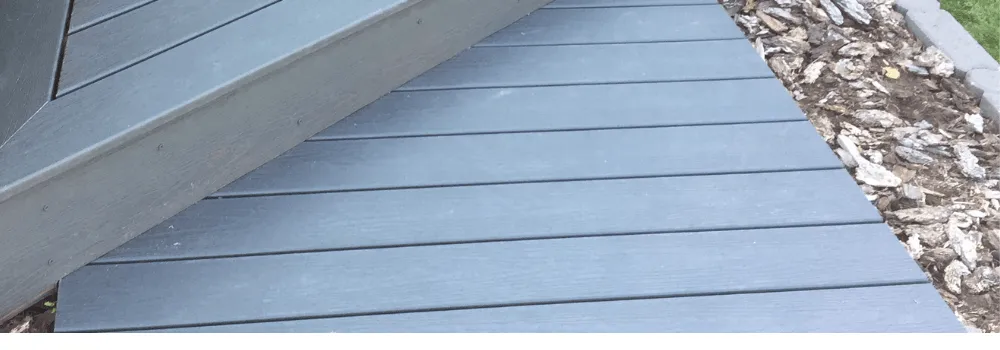There are some high moisture areas where a deck is still advantageous. Like around the pool or dockside of a lake. Even without standing water but regions with tonnes of rain, with little time between showers for decking to dry out. Decking can be exposed to high levels of moisture.
One of the advantages of composite decking is its low maintenance and resistance to mould growth. But is composite decking waterproof? Will composite decking absorb water when submerged in water for an extended period of time?
is its low maintenance and resistance to mould growth. But is composite decking waterproof? Will composite decking absorb water when submerged in water for an extended period of time?
Composite decking is not waterproof but is water-resistant. Composite decking will absorb water if submerge or rained on for an extended period of time. The volume of water absorbed by composite decking and how much it swells vary by manufacture.
Before discussing the exceptions and some very promising composite decking, that can be submerged in water but not damaged. We need to define the difference between waterproof and resistant. As almost all composite decking is resistant to water, but only a few are waterproof. We should also discuss what to look for when looking for waterproof decking.
HZO gives these great short definitions concerning technology and water but can be applied to decking.
gives these great short definitions concerning technology and water but can be applied to decking.
- Water-resistant: able to resist the penetration of water to some degree but not entirely
- Water-repellent: not easily penetrated by water, especially as a result of being treated for such a purpose with a surface coating
- Waterproof: impervious to water
In regards to decking and water.
Practically all decking is water-resistant. Using deck boards, you could divert running water. One reason for gaps between deck boards is to allow rain to run off the deck instead of pooling. I would never recommend using untreated wood decking, but small amounts of rain will run off an untreated deck with only minimal absorption. In fact, even treated 5/4 decking is not resistant to water, which leads us to our next level of water protection.

Rain or drops of water will bead on Water-repellent decking, as the water cannot easily penetrate the material. This is the difference between stain/sealed wood decking and not. Pine decking needs to be regularly sealed/stained to make the decking water repellent. Treatment stops fungi from eating away the decking, but the boards will still become waterlog and deuterate.
to make the decking water repellent. Treatment stops fungi from eating away the decking, but the boards will still become waterlog and deuterate.
Most composite decking is water-repellent. Being a hybrid of low-density polyethylene and some structural component such as wood, bamboo or mineral fibres. The polyethylene repels the water off the decking, protecting the water from rain.
Plus, almost all composite decking currently on the market is capped. The addition of a polymer cap increases the decking’s resistance to water. Making capped composite decking even more impervious to water, reducing the amount of damage that can occur on the decking from rain or water. With its protective shell, rain cannot penetrate the decking core, providing years of low maintenance enjoyment. More on this later.
No composite decking is waterproof. Some composite deck boards will absorb a minimal amount of water even when submerged for an extended period of time in water. But still the decking is only very highly resistant, not waterproof.
I think Trex defines and explains it best.
“[Trex decking can be install] in intermittent contact with water, i.e., splashing and not in continuous direct contact with water, the durability of the Trex decking should not be affected.”
Trex
There lies the difference. As Trex explains, most composite decking can be used in locations where the decking will be washed or exposed to water but not submerged. If the water can run off, most composite decking will not break down and will be safe to use.
Trex also recommends using stainless steel fasteners in high moisture areas. Which is a good practise with all composite decking as other fastener can quickly rust. Stainless steel screws have proven most durable, even with regular exposure to water.
Let’s get into the hard date about composite decking submerge in water. There are two common ways of comparing decking’s water resistance.
- Linear coefficient expansion
- Mass of Water Absorption
Composite Decking Swelling In Water
In short, linear coefficient expansion is how much the decking will swell after being soaked for 24 hours. How much bigger will the board measure? We are talking inches and millimetres.
We are looking at how much weight is gained for water absorption rate after soaking in water for 24 hours. Measuring in ounces or grams but translated to a percentage for comparison sake. Not really a concern for residential decks, but it is a way of measuring and comparing how waterproof the decking is. The lower the number, the less water is absorbed, the more the decking is waterproof.
| Composite Decking | Coefficient of linear expansion (swelling) |
Armadillo | 0.00 % |
Trex | 0.0 % |
Fortress Apex | 0.0 % |
MoistureShield | 0.06 % |
Fiberon Decking | 0.1 % |
Azek CCMC | 0.13 % |
Armadillo, Trex and Fortress Apex are negligent in expansion from water. With no measurable change. You can soak them, but your deck will not grow.
are negligent in expansion from water. With no measurable change. You can soak them, but your deck will not grow.
Azek has the highest number here, but even then, it is marginal. A 20′ (6m) board will only expand by 5/16″ (8mm). There will be more movement from heat than water for Azek decking. Something that always needs to be accounted for with composite decking.
An interesting side note. Fortress, which gives much more detailed information for swelling. Their decking has a measurable thickness change. Marginal, like so little that I challenge you to measure the difference with your tape, but they still record a small change of thickness but not length or width. I am curious if all composite decking is equally impacted or only Fortress.
Composite Decking Water Absortion Levels
| Composite Decking | %mass Water Absorption after 24 hours |
| Deckorators(MPC) Voyage, Vault, Frontier | <0.05% |
Fortress I Series | <0.20% |
| Deckorators (WPC) Vista, TrailHead | <0.28% |
Fortress Apex | <1.12% |
TimberTech | <1.29% |
Water absorption means little in deck construction except that moving the decking after a rain may be slightly heavier. But it does show that even the best composite decking is not waterproof.
All composite decking will absorb water when submerged.
Noticeable missing on the chart is MoistureShield. This is odd as they most boldly claim that their decking can be submerged in water. A picture of a lady walking her shark underwater on their decking welcoming you to MoistureShield homepage . You can’t get much bolder than that.
. You can’t get much bolder than that.
“MoistureShield composite decking takes that durability a step further with Solid Core Difference™, our products can be installed on the water or underwater without damage from warping or swelling, even after cutting. With virtually no moisture absorption even in the most demanding environments”
MoistureShield
We can assume by their swelling test that the decking does absorb water. Water is being absorbed if there is a 0.06 % growth. Something needs to be added to increase the size of the decking.
I think their point is more about durability of the decking in contact with water.
“That means it’s the only decking product that can have direct contact with water without any structural field failures.”
MoistureShield
Yes, MoistureShield decking may absorb water; therefore is not waterproof, but it will not fail in water. In fact, they claim it has never failed on anyone’s deck. And will not fail, guaranteed for fifty years
decking may absorb water; therefore is not waterproof, but it will not fail in water. In fact, they claim it has never failed on anyone’s deck. And will not fail, guaranteed for fifty years . Now that’s a bold claim.
. Now that’s a bold claim.
When discussing composite decking being waterproof, this is the only real concern. Whether or not the decking absorbs water means little compared to if it has a negative effect on its structural strength. The decking can be a sponge for water, as long as you can still safely walk on and enjoy your deck.
How Close Can Composite Decking Be to Water?
So, if composite decking is not waterproof, how close to water can decking be installed?
Not many of us will build a dock or deck over water, but at the same time, the level of water-resistant of the decking will determine how close to the ground you can build a deck. The greater the resistance to water penetration and damage, the closer to the ground the deck can be built. The dirt having a high moisture content compounded by a high level of wood-destroying fungi.
you can build a deck. The greater the resistance to water penetration and damage, the closer to the ground the deck can be built. The dirt having a high moisture content compounded by a high level of wood-destroying fungi.
How close you can install composite decking to water, or the ground is not consistent. Some composite decking can be installed on the ground or even in water. Others need a minimum amount of clearance between the ground or water.
or even in water. Others need a minimum amount of clearance between the ground or water.

Trex composite decking is only wrapped on three sides. The underside of the decking is uncapped and unprotected. Making it the soft underbelly which water can penetrate. To prevent damage, it is best to install Trex’s decking and any decking that is not entirely capped with a minimum of 6″ (150mm) clearance from water and dirt.
But even with fully wrapped decking like TimberTech Terrain, sufficient clearance is required to aid in drying the decking underside. TimberTech does not give a minimum clearance height above water or ground, but simply requires adequate ventilation
Terrain, sufficient clearance is required to aid in drying the decking underside. TimberTech does not give a minimum clearance height above water or ground, but simply requires adequate ventilation
“For best practices, decking should not be installed in applications where ventilation and airflow cannot be achieved”
TimberTech Installation Guide
Over concrete, this is as little as 1 ½” (38mm), but above dirt or water, more is recommended due to possible movement. Concrete doesn’t splash. Water does. Requiring a little more distance of separation. In construction, separation is often defined as 6″ (150mm). I don’t see why this would be any different.
MositureShield is the only composite decking that I know of, that not only doesn’t discourage installation close to water but encourages. With bold statements of how well their decking performance both in and out of water. No, I don’t think their composite decking is waterproof, but it still performs well in water. Allowing you to install composite decking not only close to water but in water.
not only close to water but in water.
